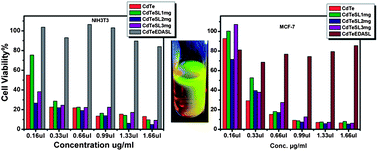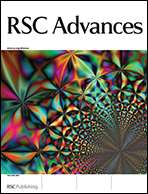Chemically conjugated sophorolipids on CdTe QDs: a biocompatible photoluminescence nanocomposite for theranostic applications†
Abstract
Functional nontoxic cadmium telluride (CdTe) quantum dots (QDs) have been synthesized using a natural functional glycolipid belonging to the family of sophorolipids (SL) as a surface-modifying agent. These SLs with open acidic form are highly suitable for QDs stabilization, are readily obtained by a fermentation process of the yeast Candida bombicola (polymorph Starmerella bombicola) in large amounts. In this work chemically stable, water soluble, and photoluminescent CdTe QDs were successfully conjugated to sophorolipids via a cross-linking reaction. The formation of SLs conjugated CdTe QDs was confirmed using different analytical techniques X-ray Diffraction (XRD), Fourier Transform Infrared Spectroscopy (FTIR), Transmission Electron Microscopy (TEM), Electron Diffraction (ED), Atomic Force Microscopy (AFM), Dynamic Light Scattering (DLS), and Photoluminescence (PL). It was shown that after being conjugated with SL the SL-CdTe QDs becomes biocompatible, still maintaining its water solubility and photoluminescence properties. The final SL coated photoluminescent CdTe QDs represent interesting biocompatible materials potentially useful for biomedical applications.


 Please wait while we load your content...
Please wait while we load your content...